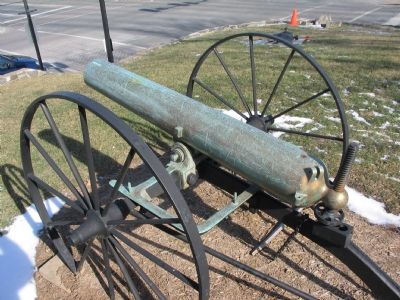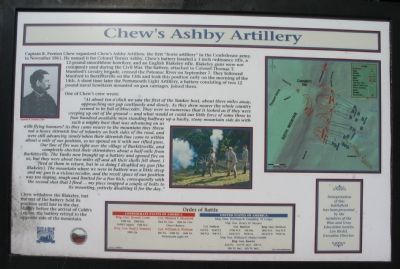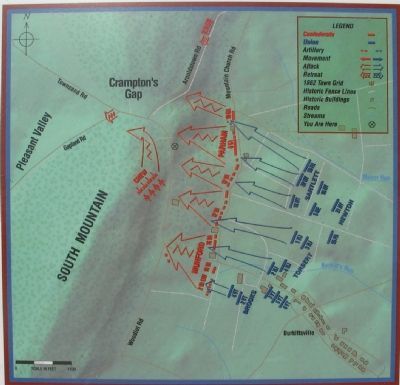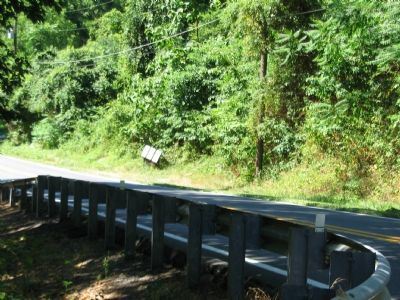Near Burkittsville in Frederick County, Maryland — The American Northeast (Mid-Atlantic)
Chew’s Ashby Artillery
One of Chew’s crew wrote: “At about ten o’clock we saw the first of the Yankee host, about three miles away, approaching our gap cautiously and slowly. As they drew nearer the whole country seemed to be full of bluecoats. They were so numerous that it looked as if they were creeping up out of the ground—and what would or could our little force of some three to four hundred available men standing halfway up a bushy, stony mountain side do with such a mighty host that was advancing on us with flying banners? As they came nearer to the mountain they threw out a heavy skirmish line of infantry on both sides of the road, and were still advancing slowly when their skirmish line came to within about a mile of our position, so we opened on it with our rifled guns. Our line of fire was right over the village of Burkittsville, and completely checked their skirmishers about a half-mile from Burkittsville. The Yanks now brought up a battery and opened fire on us, but they were about two miles off and all their shells fell short. I fired at the min return, but in doing so I disabled my gun (the Blakeley). The mountain where we were in battery was a little steep and my gun is a vicious recoiler, and the recoil space of our position was too sloping, rough and limited for a free kick, consequently with the second shot that I fired ... my piece snapped a couple of bolts to its mounting, entirely disabling it for the day.”
Chew withdrew the Blakeley, but the rest of the battery held its position until late in the day. Shortly before the arrival of Cobb’s Legion, the battery retired to the opposite side of the mountain.
Brig. Gen. Howell Cobb
16th Ga., 24th Ga., Cobb’s Legion, 15th N.C.
Brig. Gen. Paul J. Semmes
10th Ga.
Col. Thomas T. Munford
2nd Va. Cav., 12th Va. Cav., Chew’s Battery
Col. William A. Parham
6th Va., 12th Va., 16th Va., Portsmouth Light Arty.
United
States of America
Maj. Gen. William B. Franklin, VI Corps
Maj. Gen. Henry W. Slocum
Col. Torbert
1st N.J., 2nd N.J., 3rd N.J., 4th N.J.
Col. Bartlett
27th N.Y. 16th N.Y., 5th Me., 96th Pa.
Brig. Gen. Newton
18th N.Y., 31st N.Y., 32nd N.Y., 95th Pa.
Maj. Gen. William F. (Baldy) Smith
Brig. Gen. Brooks
2nd Vt., 3rd Vt. (nc), 4th Vt., 5th Vt. (nc), 6th Vt. (nc)
(nc) noncombatants
Interpretation of this battlefield has been presented by the members of the Blue and Gray Education Society, Len Riedel, Executive Director.
Erected by Blue and Gray Education Society.
Topics. This historical marker is listed in this topic list: War, US Civil. A significant historical month for this entry is September 1750.
Location. 39° 24.087′ N, 77° 38.27′ W. Marker is near Burkittsville, Maryland, in Frederick County. Marker is on Gapland Road, on the right when traveling south. Touch for map. Marker is in this post office area: Burkittsville MD 21718, United States of America. Touch for directions.
Other nearby markers. At least 8 other markers are within walking distance of this marker. “Sealed With Their Lives” (here, next to this marker); Burkittsville: Henry Burkitt’s Town (here, next to this marker); Gath's Empty Tomb (approx. ¼ mile away); Mausoleum (approx. ¼ mile away); The Confusion of Battle (approx. ¼ mile away); The 15th North Carolina (approx. ¼ mile away); Brownsville Pass: Semmes’ Gamble (approx. ¼ mile away); GATH: The Man and His Mountain (approx. ¼ mile away). Touch for a list and map of all markers in Burkittsville.
More about this marker. The marker displays a portrait of Captain R. Preston Chew, a photograph of a cannon firing, and a map of the unit dispositions at the battle.
Regarding Chew’s Ashby Artillery. "ordinance" should be "ordnance" (no "i").
Also see . . .
1. Chew’s Battery. West Virginia in the Civil War website entry (Submitted on February 25, 2022, by Larry Gertner of New York, New York.)
2. History of Chew’s Battery. R. Preston Chew's Battery website entry (Submitted on August 12, 2007, by Craig Swain of Leesburg, Virginia.)
3. Blakely rifle. Wikipedia entry (Submitted on February 25, 2022, by Larry Gertner of New York, New York.)

Photographed By Craig Swain, February 9, 2007
4. Naval Howitzer
Contrasting with Chew's rifled Blakely and Ordnance guns, the Portsmouth Artillery used smoothbore howitzers similar to this one now on display at the Fairfax, Va., Court House. Designed for use by naval landing parties, the entire weapon was easily broken down for transport by boat or cart. So light was the entire piece, the howitzer was often pulled by the gun crew as opposed to being drawn by horses. The navy howitzer also differed from standard field pieces by having an elevating screw that passed through the knob at the breech (rear) of the piece.
Credits. This page was last revised on February 25, 2022. It was originally submitted on August 12, 2007, by Craig Swain of Leesburg, Virginia. This page has been viewed 2,292 times since then and 19 times this year. Last updated on March 14, 2021, by Carl Gordon Moore Jr. of North East, Maryland. Photos: 1, 2, 3, 4. submitted on August 12, 2007, by Craig Swain of Leesburg, Virginia. • Bill Pfingsten was the editor who published this page.


